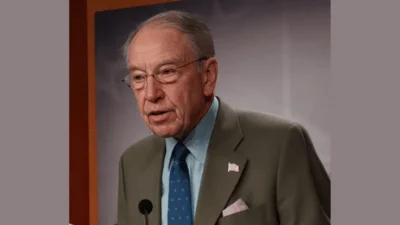The Congressional Record is a unique source of public documentation. It started in 1873, documenting nearly all the major and minor policies being discussed and debated.
“PETITIONS AND MEMORIALS” mentioning the U.S. Dept of State was published in the Senate section on pages S2215-S2218 on April 17, 2018.
The State Department is responsibly for international relations with a budget of more than $50 billion. Tenure at the State Dept. is increasingly tenuous and it's seen as an extension of the President's will, ambitions and flaws.
The publication is reproduced in full below:
PETITIONS AND MEMORIALS
The following petitions and memorials were laid before the Senate and were referred or ordered to lie on the table as indicated:
POM-199. A joint memorial adopted by the Legislature of the State of Idaho memorializing its opposition to any new federal national monument designations or further designations of wilderness in the State of Idaho without the approval of the United States Congress and the Idaho Legislature; to the Committee on Energy and Natural Resources.
Senate Joint Memorial No. 103
Whereas, the Antiquities Act was passed by the United States Congress and signed into law by President Theodore Roosevelt on June 8, 1906. The law gives the President of the United States the authority to, by presidential proclamation, create national monuments from federal lands to protect significant natural, cultural or scientific features. The law has been used more than one hundred times since its passage; and
Whereas, the Wilderness Act was passed in 1964 and, since that time, the United States Congress has designated nearly 110 million acres of federal wildlands as official wilderness, which has the highest form of protection of any federal wildland; and
Whereas, almost sixty-two percent of land in Idaho is federal land; and
Whereas, residents of the State of Idaho support multiple use of public land. Current multiple use and private land protection policies governing the management of public land in Idaho have generally served and sustained the interests of Idaho residents; and
Whereas, ranching and agriculture play a substantial role in the state's heritage and identity and should be preserved; and
Whereas, ranching, agriculture, mining, the forestry industry and recreation are primary economic drivers in the state, with agribusiness and recreation each contributing an estimated $7.6 billion, the mining industry contributing
$1.3 billion and the forestry industry contributing $2 billion to the economy annually in recent years, all of which would be substantially impacted by any land management changes; and
Whereas, Idaho residents, families and visitors currently enjoy multiple use on federal lands and have generations of family traditions. Changing federal land designations would impact local wildlife management as well as opportunities to hunt and fish; and
Whereas, changes in federal land designations or classifications would affect land use by imposing restrictions on development, resource extraction, recreation and land exchanges that would result in diminished economic opportunities and restrictions on 'access and multiple use; and
Whereas, the people of the State of Idaho value abundant water resources and water rights and have concern that new national monument designations or further designation of wilderness by Congress could affect those resources and rights; and
Whereas, the Idaho Roadless Rule is Idaho's 2006 plan that provides a framework for use and protection of more than nine million acres of federal public backcountry. The rule is viewed as a nationwide model of collaboration among groups and individuals with diverse interests and concerns; and
Whereas, the Roadless Rule specifically prescribes protective management under the wildland recreation theme, and it is feared that utilization of the Antiquities Act for new national monument designations or further designation of wilderness by Congress would overturn the agreement reached in the formulation of the Idaho Roadless Rule, with no effort to reach consensus through coordination as required by federal law; and
Whereas, several years ago, advisory votes relating to a suggested new national monument designation and a wilderness designation in Idaho were held in a number of potentially affected counties in central and eastern Idaho, both showing over ninety percent opposition to such designations. Now, therefore, be it
Resolved, By the members of the Second Regular Session of the Sixty-fourth Idaho Legislature, the Senate and the House of Representatives concurring therein, that we oppose any new federal national monument designations or further designations of wilderness in the State of Idaho without the approval of the United States Congress and the Idaho Legislature; and be it further
Resolved, That the Idaho congressional delegation is urged to introduce and support legislation to oppose any new federal national monument designations or further designations of wilderness in the State of Idaho without the approval of the United States Congress and the Idaho Legislature; and be it further
Resolved, That any efforts to reach decisions regarding lands and resources of the State of Idaho administered by federal agencies or their designees be made through the lawful coordination process as required by the National Environmental Policy Act, the Federal Land Policy and Management Act, the National Forest Management Act, the 1982 Forest Service Planning Rule and other federal acts requiring coordination, rather than by unilateral administrative processes that exclude the residents of the State of Idaho; and be it further
Resolved, That the Secretary of the Senate be, and she is hereby authorized and directed to forward a copy of this Memorial to the President of the Senate and the Speaker of the House of Representatives of Congress, and to the congressional delegation representing the State of Idaho in the Congress of the United States.
____
POM-200. A joint memorial adopted by the Legislature of the State of Idaho urging the Department of State to support several positions in negotiations with Canada regarding any modification or future implementation of the Columbia River Treaty; to the Committee on Foreign Relations.
House Joint Memorial No. 11
Whereas, since it was implemented in 1964, the Columbia River Treaty has provided for a coordinated management of the Columbia River to reduce flooding impacts and increase power generation throughout the Columbia River Basin; and
Whereas, the treaty provides that either the United States or Canada may terminate the treaty by providing written notice at least 10 years in advance of termination; and
Whereas, the U.S. and Canadian entities previously reviewed the treaty and determined that the treaty should be modified; and
Whereas, on December 7, 2017, the U.S. State Department issued a press release stating that the United States and Canada will begin negotiations to modernize the treaty in early 2018; and
Whereas, the U.S. Entity Regional Recommendation of 2013 concluded that the purposes of a ``modernized'' treaty should be expanded to include consideration of ``ecosystem-based function'' in addition to the original flood control and hydropower purposes of the treaty; and
Whereas, unless otherwise agreed to, the treaty provides that, in 2024, flood control operations will automatically shift from providing guaranteed flood control space in Canadian reservoirs to ``called upon'' flood control operations; and
Whereas, the U.S. and Canadian entities have provided differing interpretations of the ``called upon'' flood control provisions, with the U.S. Entity asserting that
``called upon'' operations apply only to dams in the Columbia River Basin specifically authorized for ``system-wide flood control,'' and the Canadian Entity taking the position that all U.S. storage projects in the Columbia River Basin must be utilized for system-wide flood control before Canadian reservoirs are called upon to provide any flood control space; and
Whereas, altered flood control operations could have devastating impacts on reservoir storage and operation levels, irrigation, recreation, hydropower, local flood control and other authorized purposes in Idaho; and
Whereas, the Canadian Entitlement, whereby the U.S. and Canadian entities share the increased power production created by coordinated river operations, has proven to be imbalanced in favor of Canada; and
Whereas, including ecosystem-based function in a modernized treaty could have adverse impacts on existing beneficial uses of the river and create greater uncertainty in a river system that is already heavily regulated; and
Whereas, the Regional Recommendation fails to recognize the substantial investment in ecosystem-based function made by Northwest region hydropower producers and their customers, including billions of dollars invested in fish passage and habitat efforts and the development and implementation of robust environmental mitigation plans; and
Whereas, navigation should be protected, and adverse flows should not impact the transportation channel or lock system operations: Now, therefore, be it
Resolved By the members of the Second Regular Session of the Sixty-fourth Idaho Legislature, the House of Representatives and the Senate concurring therein, that we urge the U.S. Department of State to support the following positions in negotiations with Canada regarding any modification or future implementation of the Columbia River Treaty:
(1) Recognize and protect the authorized purposes and water rights for storage projects in Idaho, including irrigation, recreation, hydropower and local flood control;
(2) Advocate that only storage projects specifically authorized by Congress for system-wide flood control may be required to provide such benefits under the treaty, with no increased flood control burden placed on projects in Idaho;
(3) Recognize a need to review and rebalance the Canadian Entitlement;
(4) Recognize the ecosystem benefits that have already been provided by storage projects in the United States pursuant to the other federal laws and refrain from advocating for additional ecosystem contributions from U.S. projects;
(5) Recognize that ecosystem restoration, as that term has been used by some proponents of modernization, is intentionally vague and if incorporated into an international treaty could be used as a vehicle to override and infringe upon existing federal environmental laws and usurp state sovereignty over water and, therefore, require any treaty modification to preserve federal environmental protection laws and state water laws and reject any additional mitigation requirement;
(6) Require any treaty modification to recognize the primary authority and state sovereignty of Idaho and its sister states over their respective water resources;
(7) Reject any attempts through the treaty modification process to incorporate the reintroduction of anadromous species above Hells Canyon or Dworshak, as such efforts are outside the scope of the treaty purposes; and
(8) Protect navigation so that adverse flows do not impact the transportation channel or block system operations; and be it further
Resolved, That the Chief Clerk of the House of Representatives be, and she is hereby authorized and directed to forward a copy of this Memorial to the President of the Senate and the Speaker of the House of Representatives of Congress, and to the congressional delegation representing the State of Idaho in the Congress of the United States, the U.S. Department of State, the Columbia River Treaty Negotiator, the U.S. Entity Coordinator, Bonneville Power Administration and the U.S. Army Corps of Engineers.
____
POM-201. A joint resolution adopted by the Legislature of the State of Wyoming commemorating the one hundred fiftieth
(150th) anniversary of the signing of the 1868 Treaty of Fort Bridger; to the Committee on Indian Affairs.
Enrolled Joint Resolution No. 3
Whereas, the Shoshone (eastern band) and the Bannock Tribes of Indians, presently known as the Eastern Shoshone and Shoshone-Bannock Tribes, entered into a treaty with the United States of America on July 3, 1868 at Fort Bridger, in the Utah Territory, which is now present day Wyoming; and
Whereas, each of the Tribes and the United States Government desiring for peace to continue among and between themselves signed the 1868 Treaty of Fort Bridger to keep and maintain peace; and
Whereas, the legacy of the 1868 Treaty of Fort Bridger has had an impact in numerous ways on the lives of Tribal members of both Tribes from generation to generation since the signing; and
Whereas, members of both the Eastern Shoshone and the Shoshone-Bannock Tribes have endured difficult burdens, sometimes navigating treacherous trails in their dedicated effort to preserve and pass along their physical and cultural identity, while at the same time making significant contributions to the development of the Republic; and
Whereas, the Eastern Shoshone and Shoshone-Bannock Tribes plan a sesquicentennial treaty reenactment ceremony at Fort Bridger State Historic Site to honor the spirit of this area's rich past and its First Nations, with celebrations open to the public on July 3, 2018, including the reenactment between the Tribes and military slated for 10:00 a.m. and dances, feasts and games throughout the day; and
Whereas, Wyoming values and respects the historical and modern contributions of American Indian people, as evidenced by the 2017 passage of the American Indian Educational Program Act, which will educate all Wyoming students about American Indian tribes of the region, to ensure the cultural heritage, history and contemporary contributions of American Indians are addressed; and
Whereas, the Eastern Shoshone and the Shoshone-Bannock Nations and their people continue to be integral components of American society. Now, therefore be it
Resolved, By the members of the Legislature of the State of Wyoming:
Section 1.--That the Wyoming legislature commemorates the one hundred fiftieth (150th) anniversary of the signing of the 1868 Treaty of Fort Bridger by educating native and nonnative people about the Treaty and by illustrating that the Eastern Shoshone and Shoshone-Bannock Tribes continue to be significant contributors to the success of this country and its future with forward-looking, positive relationships with the United States Government and each of the several states.
Section 2.--That the Wyoming legislature supports nationwide public education about the heritage, history and contributions of Native American tribes and urges the federal government to uphold its federal trust responsibilities.
Section 3.--That the Wyoming legislature supports permanently displaying in Wyoming the original 1868 Treaty of Fort Bridger, which is presently on file with the National Archives.
Section 4.--That the Secretary of State of Wyoming transmit copies of this resolution to the President of the United States, the Secretary of the Interior, the Speaker of the United States House of Representatives, the President Pro Tempore of the United States Senate and the majority and minority leader and whip of each house, the Wyoming Congressional Delegation, each state governor and the business councils of the Eastern Shoshone and Shoshone-Bannock Tribes.
____
POM-202. A joint resolution adopted by the Legislature of the State of Wyoming commemorating the one hundred fiftieth
(150th) anniversary of the signing of the 1868 Treaty of Fort Laramie; to the Committee on Indian Affairs.
Enrolled Joint Resolution No. 1
Whereas, the area in and around what is presently known as Fort Laramie, Wyoming has served like a grand meeting hall, described by author Starley Talbott as a place ``where the mountains meet the plains; where two rivers converge; where Native American tribes gathered; where fur trappers and traders rendezvoused; where emigrants met for rest and supplies; where soldiers came and went; where homesteaders linked the past to the present; and where today's travelers come to partake in Fort Laramie's fascinating history;'' and
Whereas, Fort Laramie and its surrounding area had been occupied by tribes of the Great Plains throughout the course of history; and
Whereas, in 1812, Robert Stuart was the first non-Indian person to visit the area later known as Fort Laramie and Alfred Jacob Miller became the first artist to record the area's landscape in 1837; and
Whereas, beginning in 1841, emigrants bound for the West Coast stopped in Fort Laramie as they traveled to what would later become the Oregon, California and Mormon Trails, with westward migration peaking in the early 1850s at more than fifty thousand (50,000) people traveling these trails annually; and
Whereas, the United States military purchased the Fort Laramie Post in 1849 and stationed soldiers to protect wagon trains, thereby establishing a social and economic center for Indians and non-Indians; and
Whereas, despite efforts to secure peace between Native Americans and the non-Indian emigrants and military personnel, conflicts arose, culminating in wars between Plains Tribes and the United States; and
Whereas, the indigenous Nations of the northern Great Plains region entered into treaties with the United States of America in 1868 at Fort Laramie, in the Dakota Territory, which is now present day Wyoming, and at other military posts in the region; and
Whereas, these treaties are collectively regarded as the 1868 Treaty of Fort Laramie and include the following Tribes in treaty with the United States:
Treaty with the Sioux and Arapaho
Brule band of Sioux (presently ``Brule Lakota'': Lower Brule and Rosebud Reservations)
Ogallalah band of Sioux (presently ``Oglala Lakota'': Pine Ridge Reservation)
Minneconjou band of Sioux (presently ``Miniconjou Lakota'': Cheyenne River Reservation)
Yanktonai band of Sioux (presently ``Yanktonai Dakota'' and
``Yankton'': Standing Rock, Yankton and Crow Creek Reservations)
Arapaho (presently ``Southern Arapaho'': headquartered in Concho, Oklahoma, Cheyenne-Arapaho Oklahoma Tribal Statistical Area)
Hunkpapa band of Sioux (presently ``Hunkpapa Lakota'': Standing Rock Reservation)
Blackfeet band of Sioux (also ``Blackfoot,'' presently
``Blackfeet Lakota'': Cheyenne River and Standing Rock Reservations)
Cuthead band of Sioux (presently ``Cuthead Dakota'': Standing Rock Reservation)
Two Kettle band of Sioux (presently ``Two Kettle Lakota'': Cheyenne River Reservation)
Sans Arc band of Sioux (presently ``Sans Arc Lakota'': Cheyenne River Reservation)
Santee band of Sioux (presently ``Santee Dakota'': Santee Sioux, Flandreau, Crow Creek and Lake Traverse Reservations and the Upper Sioux, Lower Sioux, Prairie Island and Shakopee Mdewakanton Indian Communities)
Treaty with the Crow (Crow Reservation)
Treaty with the Northern Cheyenne and Northern Arapaho
(Northern Cheyenne and Wind River Reservations, respectively); and
Whereas, each of the Tribes and the United States Government desiring for peace, the parties signed the 1868 Treaty of Fort Laramie to cease wars among the parties and bring about and maintain peace; and
Whereas, the 1868 Treaty of Fort Laramie did not end conflict, as terms of the Treaty were broken resulting from the discovery of gold in the Black Hills, the area of Fort Laramie remained a supply and communications center for the United States military's efforts to confine Native people onto reservations; and
Whereas, the United States military abandoned Fort Laramie in 1890, and all but one (1) of the fort's sixty (60) structures were sold at private auction and were used as private dwellings, businesses, a dance hall and livestock shelters during the fort's homestead period of 1890 to 1937; and
Whereas, interested homesteaders, local residents and others recognized the historical significance of Fort Laramie in the 1930s and the State of Wyoming acquired Fort Laramie in 1937, which eventually became a unit of the national park system in 1938; and
Whereas, today, the Fort Laramie National Historic Site is open to the public and restoration of many of the structures to their historic appearances provides visitors with a glimpse of a bygone era; and
Whereas, the legacy of the 1868 Treaty of Fort Laramie has had an impact in numerous ways on the lives of Tribal members of Tribes party to the Treaty from generation to generation since the signing; and
Whereas, the indigenous Nations of the northern Great Plains and their people have endured difficult burdens, sometimes navigating treacherous trails in their dedicated effort to preserve and pass along their physical and cultural identity, while at the same time making significant contributions to the development of the Republic; and
Whereas, the indigenous Nations of the northern Great Plains and their people continue to defend their inherent sovereignty and celebrate their cultural heritage; and
Whereas, the anniversary of the signing of the 1868 Treaty of Fort Laramie will be commemorated throughout 2018 at the Fort Laramie National Historic Site to honor the spirit of this area's rich past and its First Nations, with events from sunrise to sunset slated for April 28 and ending festivities on November 6. Throughout the anniversary year, celebrations will commemorate individual Tribe signing dates and may include traditional culture and history demonstrations; and
Whereas, Wyoming values and respects the historical and modern contributions of American Indian people, as evidenced by the 2017 passage of the American Indian Educational Program Act, which will educate all Wyoming students about American Indian tribes of the region, to ensure the cultural heritage, history and contemporary contributions of American Indians are addressed. Now, therefore, be it
Resolved, By the members of the Legislature of the State of Wyoming:
Section 1.--That the Wyoming legislature commemorates the one hundred fiftieth (150th) anniversary of the signing of the 1868 Treaty of Fort Laramie by educating people about the Treaty and history of this nationally significant place.
Section 2.--That the Wyoming legislature supports nationwide public education about the heritage, history and contributions of Native American tribes and urges the federal government to uphold its federal trust responsibilities.
Section 3.--That the Wyoming legislature supports permanently displaying in Wyoming the original treaties that comprise the 1868 Treaty of Fort Laramie, which are presently on file with the National Archives.
Section 4.--That the Secretary of State of Wyoming transmit copies of this resolution to the President of the United States, the Secretary of the Interior, the Speaker of the United States House of Representatives, the President Pro Tempore of the United States Senate and the majority and minority leader and whip of each house, the Wyoming Congressional Delegation, each state governor and the business council of each tribal nation that signed the 1868 Treaty of Fort Laramie.
____
POM-203. A joint memorial adopted by the Legislature of the State of Idaho requesting a permanent exemption from the U.S. Department of Transportation--Federal Motor Carrier Safety Administration electronic logging devices mandate granted by whichever means appropriate for livestock and agriculture commodity transporters; to the Committee on Commerce, Science, and Transportation.
Senate Joint Memorial No. 104
Whereas, the 2012 federal transportation bill, MAP-21, mandated electronic logging devices (ELD) in commercial trucks, which were to be finalized by rule in 2015, with an implementation date of December 18, 2017, in trucks of model year 2000 and newer; and
Whereas, because of the nature of the commodities hauled and normal industry scheduling uncertainty, livestock and agriculture commodity haulers requested exemption from this mandated transition from handwritten logbooks to the electronic log, and the United States Department of Transportation (USDOT) and the Federal Motor Carrier Safety Administration (FMCSA) originally ignored the request and agriculture commodity haulers; and
Whereas, the federal mandate and rule decreases efficiency, increases business expense and does little or nothing to improve safety in this segment of the trucking industry, and USDOT-FMCSA has not considered the special circumstances surrounding the transport of livestock, fish and insects, as these are the most perishable and fragile of all commodities and must be transported in the most efficient, timely and expedient manner as possible, and conformity with the ELD mandate and existing hours of services rule would result in delays off-loading and reloading of livestock and even the addition of a second driver on short hauls; and
Whereas, infrastructure for off-loading and holding of livestock do not readily exist and, if it did, extra handling of cargo would result in added stress, weight loss, additional expense and exposure to additional disease and biohazard, with no positive benefit to the animals; and
Whereas, heavy machinery service vehicles often drive long distances to reach a job site and remain at the location long enough to exceed the 14-hour service day thereby requiring either an additional driver or an overnight stay near the job site and subsequently decreasing efficiency and increasing business expense; and
Whereas, highway safety is also a primary consideration, and livestock transporters were involved in a statistically insignificant number of accidents (0.004%) according to the
``Large Truck Crash Causation Study'' published by the FMCSA and the National Highway Safety Institute and 0.7% of fatal accidents per the ``Trucks Involved in Fatal Accidents Factbook 2005'' published by the Transportation Research Institute; and
Whereas, mandated ELDs engage when the truck's motor is started. The devices provide the operator no discretion in determining ``on-duty'' and ``off-duty'' time. Large, over-the-road commercial truck fleets support the ELD mandate because they are better able to absorb related costs and are subject to well-defined schedules; and
Whereas, paper logs allow the driver this determination. Because many livestock and agriculture commodity haulers are small and independently owned businesses, mandatory ELD use will result in increased livestock handling, more downtime, increased expenses, and lower net revenues to producers and trucking firms and small trucking companies forced out of business. The ELD mandate is impractical because USDOT-FMCSA did not consider normal delays that are encountered when dealing with livestock and other agriculture commodities; and
Whereas, in September 2017, seven national agriculture commodity organizations and other agriculture-related organizations requested a waiver from the rule, which was granted and will be in effect until March 18, 2018. Section 132, Exemption from Requirement for Electronic Logging Device, is contained in the FY18 federal Transportation, Housing and Urban Development (THUD) bill funding to implement the ELD mandate in FY18, and this language was signed by all members of Idaho' s congressional delegation, and legislation was introduced in 2017 in the United States House of Representatives to make a livestock/agriculture commodity exemption permanent; and
Whereas, the federal mandate and rule is difficult to implement, increases cost, lowers efficiency, imposes an unfunded mandate, creates economic and regulatory hardship for small business and does not consider the special needs of certain segments of the trucking industry: Now, therefore, be it
Resolved, By the members of the Second Regular Session of the Sixty-fourth Idaho Legislature, the Senate and the House of Representatives concurring therein, that we request a permanent exemption from the USDOT-FMCSA ELD mandate granted by whichever means appropriate for livestock and agriculture commodity transporters; and be it further
Resolved, That the Secretary of the Senate be, and she is hereby authorized and directed to forward a copy of this Memorial to the President of the Senate and the Speaker of the House of Representatives of Congress, and to the congressional delegation representing the State of Idaho in the Congress of the United States, the United States Department of Transportation and the Federal Motor Carrier Safety Administration.
____
POM-204. A resolution approved by the Mayor and City Council of the City of Rice Lake, Wisconsin, supporting the passage of an amendment to the United States Constitution stating: only human beings are endowed with Constitutional rights-not corporations, unions, non-profits or other artificial entities; and money is not speech, and therefore regulating political contributions and spending is not equivalent to limiting political speech; to the Committee on the Judiciary.
____________________








